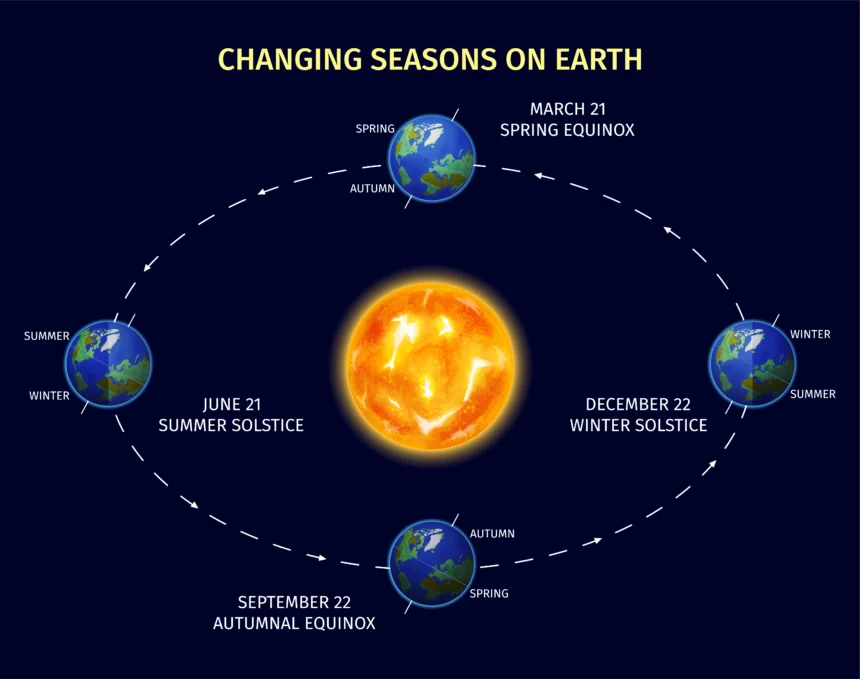Have you ever wondered why summer days are so long, but darkness falls so quickly in winter? The secret lies in the Earth’s tilt and journey around the sun, creating solstices and equinoxes—but what’s the difference? You’re not alone if you are scratching your head about Earth’s rhythm! Let’s find out the difference between a solstice and an equinox.
⫸ Introduction
Solstices and equinoxes are pivotal astronomical events that define the rhythm of our planet. These phenomena occur due to Earth’s tilted axis as it orbits the Sun. They profoundly impact the amount of daylight we experience, ultimately shaping the changing seasons. Additionally, solstices and equinoxes hold immense cultural significance, with many traditions and celebrations historically tied to these key moments in Earth’s celestial journey.
⫸ What is a Solstice?
A solstice is an astronomical event that marks a turning point in the Earth’s annual journey around the sun. It occurs when our planet’s tilted axis causes one hemisphere to receive its maximum or minimum amount of sunlight during a single day.
Meaning of ‘solstice’
The word “solstice” comes from Latin, meaning “sun stands still.” It refers to how the Sun’s apparent movement in the sky pauses briefly as it reaches its northernmost or southernmost point relative to the equator.
How many solstices do we have?
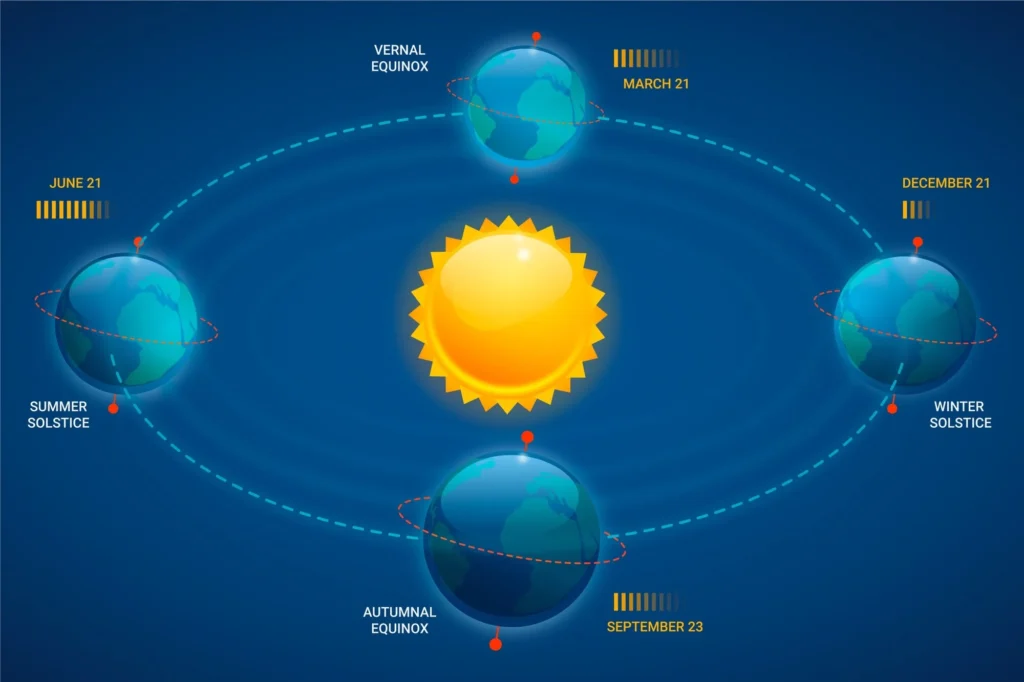
- Summer Solstice: 21st June is the summer solstice day. This is the day with the longest daylight hours, marking the beginning of summer. The Sun is directly over the Tropic of Cancer.
- Winter Solstice: 22nd December is the winter solstice day. This is the day with the shortest daylight hours, marking the beginning of winter. The Sun is directly over the Tropic of Capricorn.
What causes the solstices?
The Earth’s 23.5-degree tilt causes solstices. This tilt isn’t straight up and down; it stays at an angle as Earth orbits the Sun. During a solstice, one hemisphere leans most directly towards the Sun. This hemisphere receives more focused sunlight, longer days, and warmer temperatures. The opposite hemisphere leans away, receiving less sunlight and experiencing winter conditions.
⫸ What is an Equinox?
An equinox is a fascinating astronomical event that marks a special balance between day and night across the globe. Understanding equinoxes helps us grasp the rhythm of our planet and the changing seasons.
Meaning of ‘equinox’
The word “equinox” comes from the Latin aequus (equal) and nox (night). An equinox occurs when the Sun’s center crosses directly over the Earth’s equator. This results in nearly equal hours of daylight and darkness across the planet.
How many equinoxes do we have?
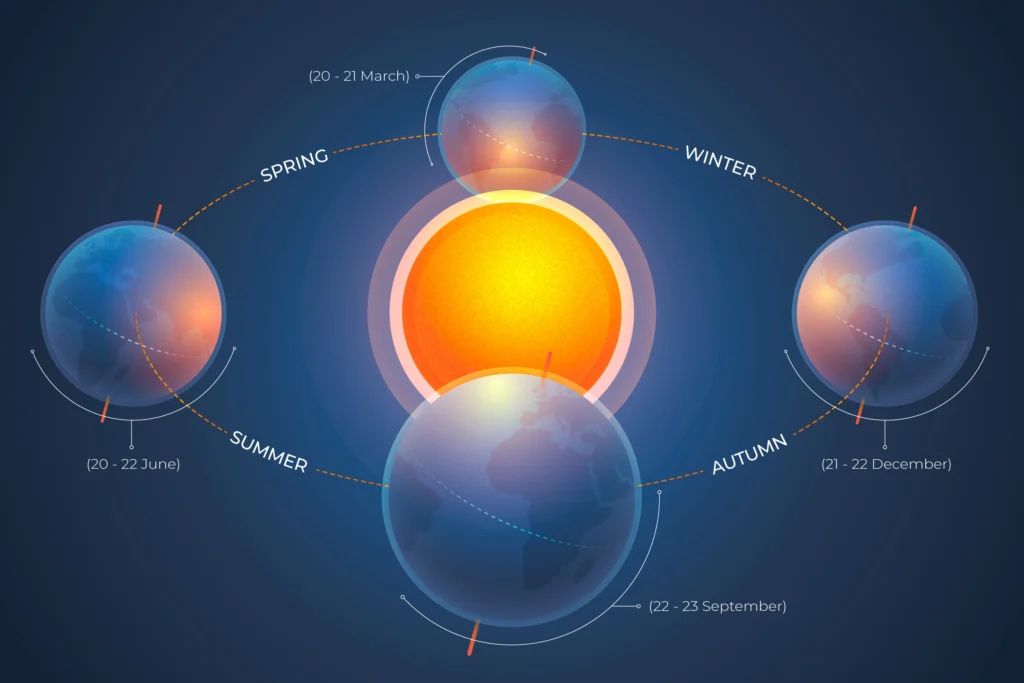
There are two equinoxes each year:
- Vernal (Spring) Equinox: In the Northern Hemisphere, it occurs around March 21st, marking the beginning of spring.
- Autumnal (Fall) Equinox: In the Northern Hemisphere, it occurs around September 23rd, signaling the start of autumn.
What causes the equinoxes?
While it’s true that daylight and darkness are approximately equal on an equinox, there are a few factors that create slight variations:
- Atmospheric refraction: The bending of the Sun’s light as it passes through Earth’s atmosphere makes the day slightly longer.
- Size of the Sun’s disk: We measure sunrise and sunset based on the edge of the Sun’s disk, not its center.
- Location: Areas very close to the equator will experience the closest to a true 12-hour day and night
⫸ Difference Between a Solstice and an Equinox
Solstices and equinoxes mark pivotal points in Earth’s annual journey around the sun. Understanding the difference between a solstice and an equinox unlocks the secrets of our changing seasons and the varying lengths of day and night. Here’s a breakdown of the key factors that distinguish these events:
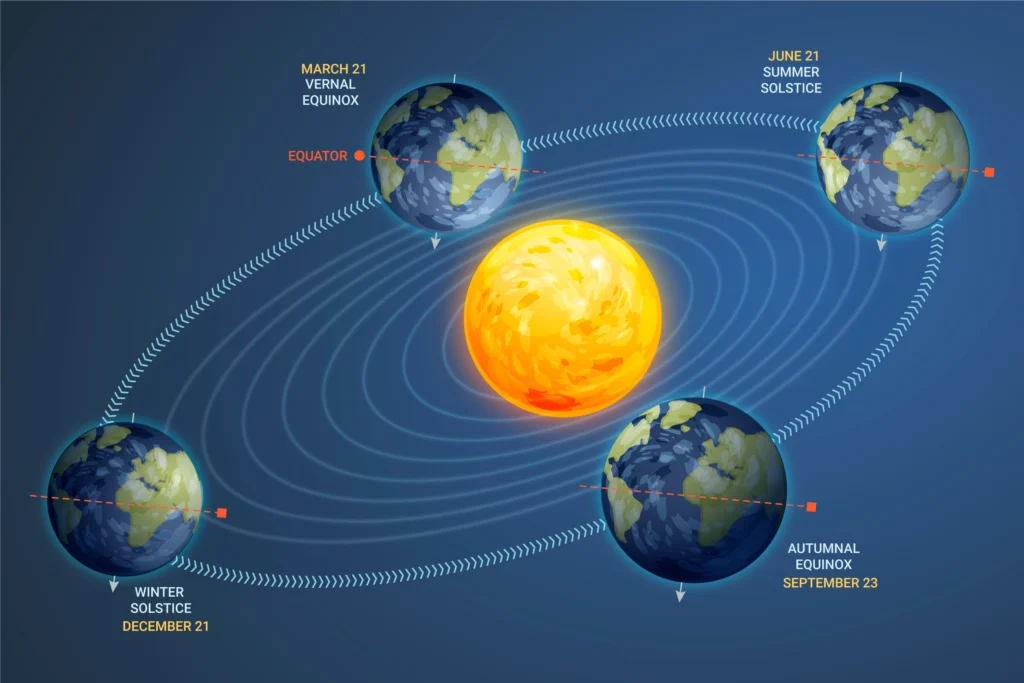
Tilt of Earth's Axis
Our planet doesn’t sit perfectly upright in space. Instead, it’s tilted on its axis by about 23.5 degrees. This tilt is the root cause of solstices and equinoxes. As Earth orbits the sun, different parts of the planet are angled more directly towards or away from our star’s rays at different times of the year.

Position of the Sun
During a solstice, the Sun reaches its highest or lowest point in the sky relative to the Earth. On the summer solstice, the Sun is directly overhead at the Tropic of Cancer, and on the winter solstice, it’s directly over the Tropic of Capricorn. During equinoxes, the Sun shines directly over the Equator.
Length of Daylight
The most noticeable difference between a solstice and an equinox is the length of daylight. Solstices mark the longest and shortest days of the year. The summer solstice boasts the most daylight, while the winter solstice has the least. Equinoxes are characterized by an almost equal division of daylight and nighttime hours worldwide.
⫸ Cultural Significance of Solstices and Equinoxes
Solstices and equinoxes haven’t just been astronomical events; they’ve held deep meaning for civilizations throughout history. These moments of transition were often marked with rituals, celebrations, and the construction of remarkable structures aligned with the sun’s position.
Ancient Celebrations and Monuments
Many ancient cultures built monuments that perfectly aligned with solstices and equinoxes. Stonehenge in England is a prime example—on the summer solstice, the sun rises directly over the Heel Stone. Across the globe, Newgrange in Ireland illuminates its inner chamber only on the winter solstice. These structures show ancient societies’ deep understanding of the Earth’s relationship with the sun. Festivals were widespread, like the Inti Raymi celebration of the summer solstice in the Inca Empire.
Modern-Day Significance
While the astronomical underpinnings of solstices and equinoxes are better understood now, these events still hold significance for many. Pagans and Wiccans often celebrate the solstices and equinoxes as part of the Wheel of the Year. For others, these are moments of reflection, a time to appreciate the changing seasons and the Earth’s cyclical nature. Whether through spiritual practice or simple observation, solstices and equinoxes connect to the patterns of the natural world.
⫸ Conclusion
Let’s wrap up our exploration into the fascinating world of solstices and equinoxes. By now, you have a solid understanding of the difference between a solstice and an equinox and their profound influence on our planet.
Recap of key differences
- Daylight Hours: Solstices mark the longest and shortest days of the year, while equinoxes signal days and nights of equal length.
- Sun’s Position: During a solstice, the sun reaches its highest or lowest point in the sky relative to the equator. With an equinox, the sun shines directly over the equator.
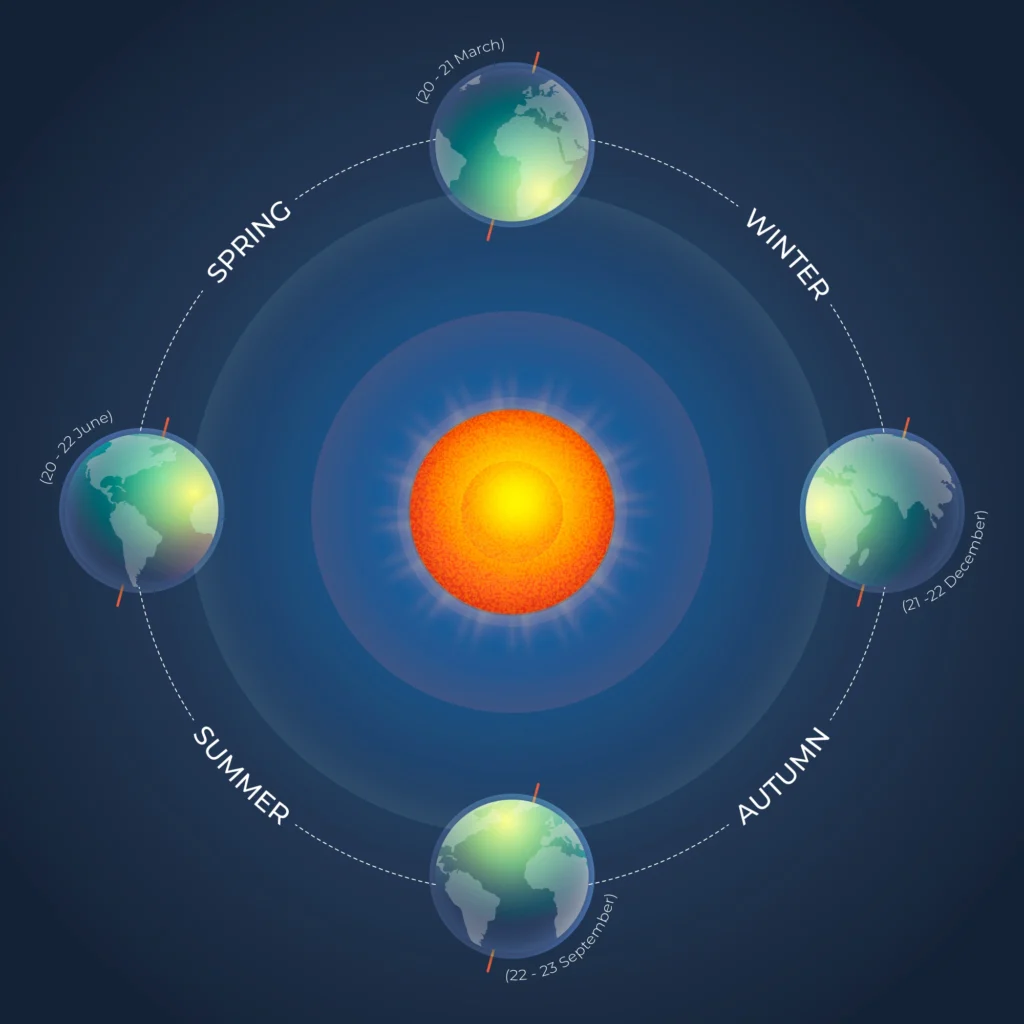
The role of solstices and equinoxes in shaping Earth's seasons
Solstices and equinoxes aren’t just interesting astronomical events – they are why we experience the changing seasons. Due to the Earth’s tilt, different hemispheres receive varying amounts of sunlight throughout the year. Solstices and equinoxes mark the transitions between these periods, dictating the rhythms of nature around the globe.

